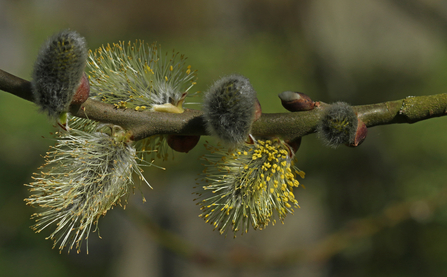I've always ben fascinated by pussy willow; even now I can't resist stroking it when I'm out and about. One of my earliest memories is of stroking pussy willow whilst being held aloft by mum or dad; the soft, velvety texture feeling like a kitten’s paw or tail against my small fingers. I don't recall having any understanding that the subsequent yellow catkins that appeared a few weeks later were just the next stage of development in the life of these grey, furry oval balls.
The pendulous golden tassels of hazel, the russet colours of alder catkins, the velvety grey of the willow – the arrival of colour in our trees during February and March signals that spring is almost round the corner. These slim clusters of flowers have no petals and are, in the main, pollinated by the wind. Willows in particular, however, rely on insects for pollination and provide a really important early food source for hoverflies, bumblebees and other insects that brave the early spring temperatures.
The word catkin, by the way, is derived from the old Dutch word, katteken, for kitten. Whilst hazel catkins are also known as lamb's-tails, it's the softness of willow catkins that gives them their feline names.
The name pussy willow actually refers to two trees - the grey willow and the goat willow, also known as common or great sallow respectively. As with many of the willows, the trees are similar but find one with that's had furry grey buds and take a closer look at the leaves; goat willow has oval leaves whereas the leaves of grey willow are oblong and at least twice as long as they are wide.



